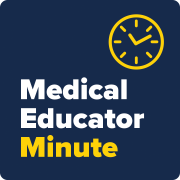Medical Educator Minute – Best practices for simulation in medical education
Medical education has learned from other professions that have established uses of simulation in training, such as aviation and the military. With limitations on duty hours potentially restricting patient encounters, and a growing emphasis on patient safety, simulation increased steadily across healthcare education. Simulation is traditionally used for learning or practicing low-frequency, high-stakes patient encounters or for procedural skills. However, more recently, simulation is being used in health profession education to practice complex communication scenarios (e.g., delivering bad news) or situations that may be emotionally charged and require an environment of psychological safety to practice (e.g., responding to microaggressions). Beyond traditional simulation, new and innovative ways of using simulation are emerging in medical education, including rapid cycle deliberate practice, ‘just in time’ simulation, and group simulation (stay tuned for future MEMs to learn more about these!).
Features of high-fidelity simulation that lead to effective learning:
Curriculum Integration
The simulation experience must be planned, scheduled, implemented, and evaluated in the context of a broader medical curriculum.
Feedback
A critical component of learning, use the three Ps for simulation: Plan, Pre-brief/Prepare, and Provide feedback/debrief
Deliberate Practice
Involves repetitive performance of cognitive or psychomotor skills with specific and rigorous skills assessment; must have multiple SIM experiences that are not exactly the same
Mastery Learning
The goal of mastery learning is to ensure that all learners achieve the objective level of mastery performance, a higher level than competence alone – some learners may require more time/practice than others
Range of Difficulty
Learning is most effective when trainees begin at an appropriate level for them, demonstrate performance mastery at that level, then advance through increasing levels of difficulty
Capturing Clinical Variation
Simulations that encompass a variety of patient presentations are far more effective for learning than those having a single case, presentation, or scenario
Individualized Learning
It’s not only about learning at one’s own level, but also about the learner being an active participant, continuously shaping and adapting the learning experience to meet their specific needs
To learn more, check out AMEE Guide #82 – Best Practices for Simulation in Healthcare Education




